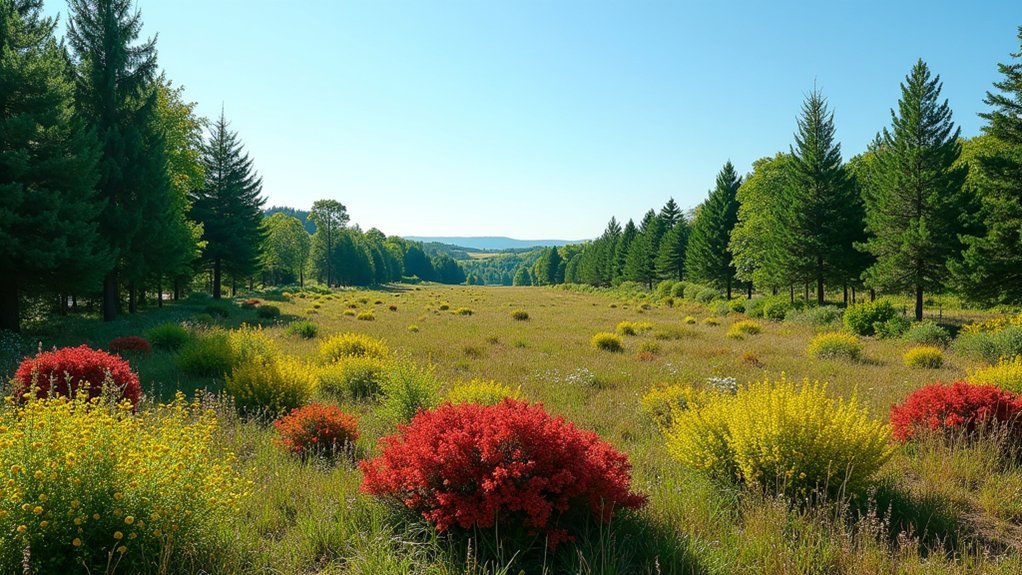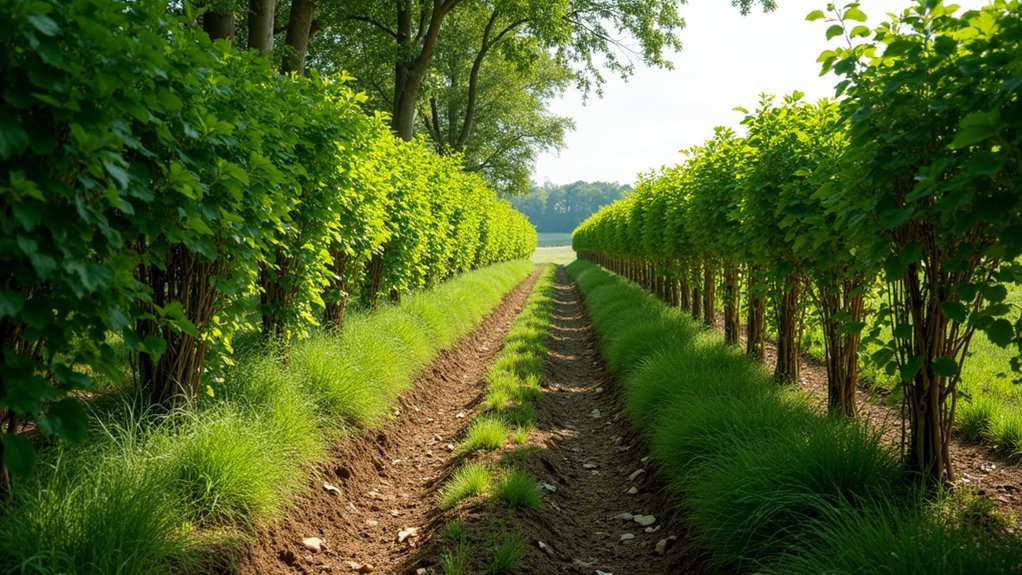Planting windbreaks shields your livestock from harsh weather, reducing feed costs by up to 50% during extreme cold and improving calving success rates. Position evergreens and deciduous shrubs on north and west sides of pastures for maximum protection, aiming for 50-65% density to block wind while allowing airflow. Choose native species suited to your USDA hardiness zone for best results. Proper design can create comfort zones extending up to 20 times the height of your trees.
Plant Windbreaks to Shield Your Livestock

When winter winds howl across your farmland, livestock face increased stress that can dramatically impact their health and your bottom line.
Strategic windbreaks offer powerful protection, cutting wind speeds by half and creating essential shelter zones for your animals.
A well-designed windbreak doesn’t just block air—it transforms harsh environments into protective havens where livestock can thrive.
You’ll see remarkable benefits from properly designed windbreaks that include 4-5 rows of mixed deciduous and evergreen trees. Protected cattle require up to 50% less feed during extreme cold and experience a 2% higher calving success rate than unprotected herds.
For maximum winter protection, place windbreaks on the north and west sides of your pastures. This positioning not only shields livestock from harsh conditions but also manages snow accumulation and maintains access to feed and water.
In summer, these same windbreaks allow cooling breezes while blocking the most intense heat.
How Windbreaks Benefit Livestock Health and Productivity
The strategic placement of windbreaks doesn’t just offer protection—it directly impacts your livestock’s health and financial returns. By reducing wind speeds by up to 50%, these barriers considerably decrease windchill factors that stress your cattle during harsh weather conditions.
Your operation will see tangible benefits from proper windbreak protection:
- Reduced feed requirements by 7% as animals expend less energy maintaining body temperature
- Improved calving success rates (up to 2% higher) due to lower environmental stress levels
- Decreased winter feeding costs—unprotected cattle require up to 50% more feed
Beyond winter benefits, windbreaks protect livestock year-round, improving airflow during summer to prevent heat stress.
You’ll observe fewer cases of frostbite and hypothermia, enhancing overall animal welfare and boosting your farm’s productivity and bottom line.
Selecting the Right Trees and Shrubs for Your Climate Zone

Choosing native species for your livestock windbreak provides better adaptation to local conditions and supports wildlife, while exotic species might offer specific benefits but require more care.
Your selection should align with your USDA hardiness zone to guarantee trees and shrubs can withstand winter temperatures and seasonal extremes common to your region.
In drought-prone areas, prioritize drought-tolerant varieties like junipers or certain oak species that can maintain effectiveness with minimal supplemental water.
Native vs. Exotic Species
Selecting between native and exotic species represents one of the most essential decisions you’ll make when planning livestock windbreaks.
Native species typically offer superior drought tolerance and resilience against local pests, ensuring your windbreak design remains effective for years to come. While exotic varieties might tempt you with rapid growth, they can sometimes become invasive without proper management.
For ideal windbreak effectiveness, consider:
- Combining native species with carefully selected exotic varieties to create a diverse, resilient barrier
- Prioritizing trees and shrubs that match your specific soil conditions and climate zone
- Consulting local conservation guidelines to identify species that support both windbreak function and wildlife habitat
This balanced approach creates windbreaks that withstand environmental stressors while providing maximum protection for your livestock investment.
Hardiness Zone Considerations
Because each region presents unique climate challenges, successful windbreak designs must align with your specific USDA hardiness zone to guarantee plant survival and ideal livestock protection.
Select trees and shrubs that can withstand your area’s temperature extremes, particularly winter lows that might damage or kill less hardy species.
Prioritize native plants whenever possible—they’re naturally adapted to local conditions and typically show greater resistance to regional pests and diseases.
For maximum effectiveness, combine deciduous trees with evergreen trees in your windbreak system. Evergreens provide essential year-round wind protection, while deciduous trees offer additional summer shade benefits for your livestock.
Remember that proper spacing between plants varies by species and zone.
Consult your local extension office for hardiness zone-specific recommendations to confirm optimal density for wind reduction without compromising plant health.
Drought-Tolerant Varieties
While water conservation remains essential for sustainable agriculture, drought-tolerant varieties offer exceptional windbreak solutions for arid and semi-arid regions.
When establishing windbreaks that provide protection year-round, select trees and shrubs that thrive with minimal irrigation once established.
- Eastern Red Cedar and Ponderosa Pine deliver excellent winter protection while requiring little water compared to other conifers.
- Deep-rooted species like Honeylocust and Black Walnut enhance drought resistance while improving soil moisture retention.
- Deciduous options such as Bur Oak and Hackberry withstand dry conditions while providing seasonal shade.
Group your drought-tolerant plants in strategic clusters to maximize water efficiency.
Your local Cooperative Extension office can recommend specific varieties best suited to your climate zone, ensuring your windbreak remains robust through drought conditions while protecting your livestock investment.
Strategic Placement: Where to Position Your Windbreak

Position your windbreak on the north and west sides of your livestock area to block those harsh prevailing winter winds and create a comfort zone that extends 10-20 times the height of your trees.
You’ll want to guarantee your windbreak extends beyond the protected area to prevent wind from curling around the ends, while strategically managing snow accumulation away from feed bunks and waterers.
Consider your existing farm facilities when planning placement, making sure access roads remain usable while maximizing protection for areas where animals congregate during severe weather.
Prevailing Wind Direction
The most critical factor in effective windbreak placement is understanding your region’s prevailing winds.
Position your windbreaks perpendicular to harsh winter winds, typically on the north and west sides of your livestock area. This strategic placement can reduce wind speeds by up to 50%, creating a protected zone that extends 10-20 times the height of your trees.
For ideal protection throughout winter:
- Place primary windbreaks on north and west sides to block the dominant cold winds
- Consider additional south-facing windbreaks if you’re in the Upper Midwest to protect against late winter storms
- Position feed and water sources outside the 2H-3H zone where snow typically accumulates
Remember that proper orientation maximizes your windbreak’s effectiveness, ensuring your livestock remain sheltered during the coldest months when they need protection most.
Seasonal Protection Areas
Beyond wind direction, strategic seasonal placement of your windbreaks creates year-round comfort zones for livestock. Position windbreaks on north and west sides at approximately 20 times their height downwind for maximum protection. This placement helps windbreaks protect animals during harsh winter months when they’re most vulnerable.
| Season | Protection Need | Windbreak Benefit |
|---|---|---|
| Winter | Severe cold | Reduces mortality |
| Spring | Lambing/calving | Provides shelter |
| Summer | Heat stress | Creates shade |
| Fall | Early storms | Reduces feed costs |
| Year-round | All weather | Improves weight gain |
Implement a Multi-Row Design with coniferous trees and deciduous shrubs to provide shelter year-round. This approach prevents problematic snow accumulation while ensuring proper drainage around feeding areas. Your local Cooperative Extension office can help you customize windbreak designs for your specific climate and livestock needs.
Farm Facility Considerations
When determining where to place your windbreaks around farm facilities, strategic positioning becomes critical for maximizing livestock protection and operational efficiency.
Position your windbreaks on the north and west sides of your livestock areas to shield animals from harsh cold winter winds and reduce windchill effects.
- Design windbreaks to extend their protection zone up to 20 times their height downwind, ensuring thorough coverage for your livestock areas.
- Implement multi-row designs using both deciduous and coniferous trees to create dense barriers that provide maximum protection year-round.
- Consider drainage patterns when positioning rows of trees to prevent problematic snow accumulation that could block access to essential feed and water sources.
For ideal results, incorporate shorter shrubs alongside taller trees to increase density and improve the windbreak’s effectiveness against drifting snow.
Optimal Density: Finding the Balance Between Blocking and Filtering Wind

Finding the right density for your livestock windbreak requires careful planning and consideration of multiple factors. The ideal density of 50-65% provides effective wind protection while allowing some airflow, creating a larger protected area. For energy costs reduction, aim for 65% or higher density using twin rows of evergreens. This denser barrier can greatly lower feed requirements as your cattle will experience less stress from cold winds.
| Density Level | Best Uses | Recommended Design | Benefits | Spacing |
|---|---|---|---|---|
| 25-50% | Crop protection | 1 row shrubs, 2 rows trees | Reduces soil erosion | Shrubs: 3-6′ apart |
| 50-65% | General wind protection | Twin rows of mixed species | Balanced protection | Trees: 10-15′ apart |
| 65%+ | Livestock shelter | Twin rows of evergreens | Reduces energy costs | 6-10′ between rows |
| 40-60% | Wildlife habitat | Mixed species design | Enhances biodiversity | 20′ between tree rows |
| 50-60% | Cattle comfort | Staggered planting pattern | Decreases feed needs | Varies by species |
Natural vs. Artificial Windbreaks: Comparing Long-term Solutions
While natural windbreaks with diverse trees and shrubs offer impressive biodiversity benefits and can reduce wind speeds by 50% over decades, artificial windbreaks made from steel or straw bales provide immediate protection and faster implementation.
You’ll find that natural options create valuable microclimates extending protection up to 20 times their height, whereas artificial barriers need a precise 20% open to 80% solid ratio for ideal function.
Though artificial solutions require more frequent maintenance and replacement, natural windbreaks deliver superior long-term value through enhanced soil quality, wildlife habitat, and sustained livestock comfort with minimal upkeep.
NATURAL WINDBREAKS
Three critical advantages make natural windbreaks superior long-term solutions for livestock protection compared to artificial alternatives.
When you plant strategic combinations of trees and shrubs, you’re harnessing natural resources that continually improve with age. Windbreaks can provide protection for an area extending up to 20 times the height of your tallest trees, creating microclimates that reduce wind speeds by as much as 50%.
For maximum effectiveness:
- Plant three or more rows combining tall trees with shorter shrubs
- Select diverse species to prevent total loss from disease or pests
- Position rows perpendicular to prevailing winter winds
Your livestock will benefit from these living structures through reduced stress, improved health, and enhanced productivity – all while you create a sustainable, self-maintaining protection system that grows more valuable each year.
ARTIFICIAL ALTERNATIVES
Although natural windbreaks offer superior long-term benefits, artificial alternatives provide immediate protection when you need quick solutions for your livestock.
These structures, made from steel sheets, wood panels, or other solid materials, can reduce wind speeds dramatically—turning harsh 40 mph gusts into manageable 10 mph breezes.
While lacking the ecological benefits of living barriers, artificial windbreaks provide benefits like ready-made protection crops and livestock need during severe weather events.
They’re particularly valuable during the years you’d otherwise spend waiting for trees to mature.
Remember that artificial options require regular maintenance and offer protection for shorter distances downwind than their natural counterparts.
When planning your farm’s wind management strategy, consider combining quick artificial solutions for immediate needs with natural windbreaks for sustainable, long-term protection.
Multi-row Design: Creating Effective Protective Barriers

A strategic arrangement of multiple rows creates the most robust protection for your livestock against harsh environmental conditions. Your multi-row design should incorporate at least three rows, combining conifers, deciduous trees, and shrubs to maximize wind reduction and create wildlife habitat.
- Orient your windbreaks perpendicular to prevailing winter winds, typically on north and west sides, to effectively reduce wind speeds by up to 50%.
- Space smaller trees 10-15 feet apart within rows and 20 feet between rows; position shrubs closer at 3-6 feet apart with 6-10 feet between rows.
- Include both evergreen and deciduous species to protect livestock year-round while enhancing biodiversity.
This thoughtful arrangement guarantees your animals stay sheltered during harsh winters, reducing their feed requirements and creating a healthier microclimate for your farm.
Seasonal Considerations for Year-round Livestock Protection
While multi-row designs provide the foundational structure of your windbreak, effective livestock protection requires thoughtful adaptation to changing seasons.
During winter, your windbreak’s primary role is blocking harsh winds from the north and west, boosting feed efficiency by up to 50% and improving calving success rates by 2%.
Position windbreaks with 50-65% density to manage snow distribution, preventing drifts in feeding areas while ensuring accessible water sources.
In summer, your strategy shifts to balancing shade with proper ventilation.
You’ll need windbreaks that provide cooling shelter while allowing sufficient airflow to prevent heat stress.
This dual-season approach protects both your livestock and nearby crops from extreme conditions.
Wildlife Benefits of Integrated Windbreak Systems
Beyond their livestock protection functions, properly designed windbreaks transform your farm into a thriving wildlife haven. When you incorporate both deciduous and evergreen trees into your integrated windbreak systems, you’ll create essential habitat that supports biodiversity across your property.
These systems provide benefits to feedlots while simultaneously serving as ecological corridors.
Strategic windbreak systems deliver dual value: operational benefits for livestock operations and essential pathways for biodiversity movement.
- Mixed plantings attract diverse bird species and beneficial insects that help maintain natural pest control
- Strategic windbreak placement facilitates wildlife movement, creating safe passages between larger habitats
- Varied tree and shrub species improve soil health and water retention, supporting sustainable wildlife populations
Your windbreak isn’t just protecting livestock—it’s building a resilient ecosystem.
Maintenance Requirements for Sustainable Windbreaks
Your thriving windbreak system won’t maintain itself after planting. Regular pruning and thinning prevents overcrowding while enhancing density and effectiveness.
Include diverse species in your windbreak to protect against complete loss from pests or diseases, and inspect regularly for early detection of these threats.
Conduct seasonal checks after storms and heavy snow to identify damage requiring repair. Without prompt attention, the protective function of your windbreak could be compromised.
Apply mulch around tree bases to retain moisture, suppress weeds, and improve soil health.
Develop a long-term replanting plan to replace aging trees before they decline. This forward-thinking approach guarantees your windbreak remains effective and adaptable to changing conditions, providing continuous protection for your livestock investment.
Cost Analysis and Financial Assistance Programs
Although establishing windbreaks requires initial investment, numerous financial assistance programs can greatly reduce your out-of-pocket expenses. The USDA Conservation Reserve Program offers cost-sharing and annual payments for windbreak establishment, making sustainable practices more affordable for your operation.
Consider these available resources:
- Your local Soil Conservation Service and Soil and Water Conservation Districts maintain funding sources specifically for windbreak projects.
- Farm Service Agencies provide valuable information on specialized programs and financial assistance options.
- Cost-effective tree planting programs through local NRDs give you access to suitable species at reduced prices.
When planning your windbreak, consult local NRD staff for expert guidance on species selection and ideal design. Their recommendations will maximize both the effectiveness of your windbreak and the financial assistance you receive.
Frequently Asked Questions
Are Windbreaks Good for Livestock?
Yes, windbreaks are excellent for your livestock. They’ll reduce feed requirements, improve calving rates, protect from winter winds, decrease cold-related health issues, and create better working conditions on your farm.
What Is the Fastest Growing Windbreak?
Hybrid poplar is your fastest windbreak option, growing 5-8 feet yearly in ideal conditions. You’ll also get quick results with eastern cottonwood, black locust, and willow species for rapid wind protection.
Which Would Make a Good Wind Barrier on a Farm?
You’ll get the best wind barrier by planting multiple rows combining tall evergreens, deciduous trees, and shrubs. Position them perpendicular to prevailing winds on your farm’s north and west sides for maximum protection.
What Are the Disadvantages of Windbreak Farming?
Windbreaks require significant initial investment and maintenance. You’ll face potential issues with turbulence from poor design, pest attraction, resource competition with crops, and reduced machinery access across your farm operations.
In Summary
By investing in well-designed windbreaks, you’ll create a healthier environment for your livestock while enhancing your property’s biodiversity. Don’t overlook the long-term benefits—reduced feed costs, improved animal welfare, and potential financial assistance can offset initial expenses. Start planning your windbreak system today, and you’ll reap the rewards for decades to come as your trees mature and provide increasing protection.





Leave a Reply